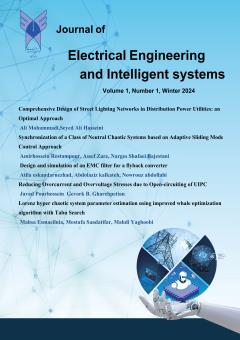کاهش تنش های اضافه ولتاژ و اضافه جریان ناشی از مدار باز شدن UIPC
الموضوعات :
جواد پورحسین
1
![]() ,
گئورک قرهپتیان
2
,
گئورک قرهپتیان
2
![]()
1 - گروه اموزشی برق قدرت، دانشکده برق، دانشگاه ازاد گناباد، گناباد، ایران
2 - دانشکده مهندسی برق- دانشگاه صنعتی امیرکبیر، تهران، ایران
الکلمات المفتاحية: کنترل کننده شارش توان, کنترل ناپیوسته, کاهش تنش اضافه جریان و اضافه ولتاژ,
ملخص المقالة :
کنترل کننده توان میان فاز یکپارچه (UIPC) اساسا یک کنترل کننده شارش توان نوع سری است که مانند یک منبع جریان رفتار می کند. از اینرو یک خطای مدار باز در ترمینال دستگاه می تواند منجر به تنش شدید شود. باز شدن ترمینال این دستگاه باعث می شود که مدار موازی دو شاخه ای (یکی RL و یکی RC) موجود در هر فاز آن، بصورت یک مدار RLC سری که از طریق دو مبدل منبع ولتاژ (VSC) محلی تحریک می شود، ظاهر شود. این وضعیت، جریان چرخشی بالا و اضافه ولتاژ شدیدی در نقطه میانی و آن یعنی در ترمینال مدار باز شده ایجاد می کند. اینها، می تواند باعث تخلیه الکتریکی و صدمه جدی به دستگاه شود. در این تحقیق، تکنیکی مبتنی بر کنترل ناپیوسته دستگاه، جهت غلبه بر مشکلات مذکور، پیشنهاد شده است. بر اساس این تکنیک، ولتاژهای تزریقی دو VSC بلافاصله بعد از خطای مدار باز به مقدارصفر باز گردانده می شوند تا جریان چرخشی و نتیجتا اضافه ولتاژ منتجه کاهش یابد. ارزیابی تکنیک پیشنهادی از طریق انجام شبیه سازی های کامپیوتری در محیط نرم افزار دیگسایلنت و سپس تحلیل نتایج در شکل منحنی صورت گرفته است. در ادامه، تحلیل و مقایسه نتایج نشان داده است که تکنیک پیشنهادی از کارایی بالایی برخوردار است. قابل به ذکر است که این تکنیک قابل اعمال به همه اعضای خانواده UIPC نیز می باشد.
[1] D. Chao, F. Wanliang, J. Lin, and N. Shuanbao, “FACTS Devices Allocation via Sparse Optimization,” IEEE Trans. Power Syst., vol. 31, no. 2, pp. 1308-1319, Mar. 2016.
[2] S. Pradeep, and T. Rajive, “Amalgam Power Flow Controller: A Novel Flexible, Reliable, and Cost-Effective Solution to Control Power Flow,” IEEE Trans. Power Syst., vol. 33, no. 3, pp. 2842-2853, May. 2018.
[3] M. O. Lawal, O. Komolafe, and T. O. Ajewole, “Power-flow-tracing-based congestion management in hydrothermal optimal power flow algorithm,” J. Mod. Power Syst. Clean Energy, Jan. 2019, Doi: 10.1007/s4056501804905.
[4] D. Divan, and H. Johal, “Distributed FACTS—A new concept for realizing grid power flow control,” IEEE Trans. Power Electron., vol. 22, no. 6, pp. 2253-2260, Nov. 2007.
[5] T. Ding, R. Bo, Z. Bie, X. Wang, “Optimal Selection of Phase Shifting Transformer Adjustment in Optimal Power Flow,” IEEE Trans. Power Syst., vol. 32, no. 3, pp. 2464–2465, May. 2017.
[6] O. Ziaee , and F. F. Choobineh, “Optimal Location-Allocation of TCSC Devices on a Transmission Network,” IEEE Trans. Power Syst., vol. 32, no. 1, pp. 94–102, Jan. 2017.
[7] M. A. chitsazan, and A. M. Trzynadlowski, “State estimation of IEEE 14 bus with interphase power controller using WLS method,” in Proc. 2016 IEEE Energy Conversion Congr. and Expo. (ECCE), Milwaukee, USA.
[8] M. Farmad, S. Farhangi, G. B. Gharehpetian, and S. Afsharnia, “Nonlinear controller design for IPC using feedback linearization method,” Int J of Elect Power and Energy Syst., vol. 44, no. 1 pp. 778–785, Jan. 2013.
[9] L. Wang, and Q. S. Vo, “Power Flow Control and Stability Improvement of Connecting an Offshore Wind Farm to a One-Machine Infinite-Bus System Using a Static Synchronous Series Compensator,” IEEE Trans. Sustain. Energy, vol. 2, no. 4, pp. 358-369, Apr. 2013.
[10] S. Galvani, M. Tarafdar Hagh, M. B. Bannae Sharifian, and B. Mohammadi-ivatloo, “Multi-Objective Predictability Based Optimal Placement and Parameters Setting of UPFC in Wind Power Included Power Systems,” IEEE Trans. Ind. Informat., Mar. 2018.
[11] J. Pourhossein, G. B. Gharehpetian, and S. H. Fathi, “Static Inter-phase Power Controller (SIPC) modeling for load flow and short circuit studies,” Energy Conversion and Manage. vol. 64, pp. 145-151, Dec. 2012.
[12] J. Pourhossein, G. B. Gharehpetian, and S. H. Fathi, “Unified Interphase Power Controller (UIPC) Modeling and Its Comparison With IPC and UPFC,” IEEE Trans. Power Del., vol. 27, no. 4, pp. 1956-1963, Oct. 2012.
[13] M. Zolfaghari, M. Abedi, and G. B. Gharehpetian, “Power flow control of interconnected AC-DC microgrids in grid-connected hybrid microgrids using modified UIPC,” To be published in IEEE Trans. Smart Grid.
[14] G. Sybille, Y. Haj-Maharsi, G. Morin, F. Beauregard, J. Brochu, J. Lemay, and P. Pelletier, “Simulator demonstration of the interphase power controller technology,” IEEE Trans. Power Del., vol. 11, no. 4, pp. 1985-1992, Oct. 1996.
[15] M. H. Haque, “Improvement of First Swing Stability Limit by Utilizing Full Benefit of Shunt FACTS Devices,” IEEE Trans. Power Syst., vol. 19, no. 4, pp. 1894-1902, Nov. 2004.
[16] P. S. Kumar, “Transient Stability Enhancement of Power System Using TCSC,” Int. J. of Elect. and Comput. Eng., vol. 2, no. 3, Apr. 2012.
[17] E. Uzunovic, C. A. Canizares, Z. Huang, Y. Ni, C. M. Shen, F. F. Wu, S. Chen, and B. Zhang, “Application of Unified Power Flow Controller in Interconnected Power Systems Modeling, Interface, Control Strategy, and Case Study,” IEEE Trans. Power Syst., vol. 15, no. 4, pp. 1461–1462, Nov. 2000.


